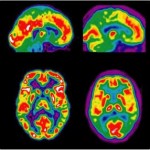ALZHEIMER’S: PATTERNS IN THE DATA, ISLANDS IN THE STREAM
Posted on August 28, 2010 by Jeffrey Newman
 A friend pointed out a front page article in the New York Times today (Aug 13, 2010) about an unusual collabortive worldwide project concerning the study of Alzheimer’s disease, tto find its biomarkers for early detection. www.nytimes.com. It shares data gained from the use of Positron Emission Tomography (PET) Scans of early Alzheimer’s disease patients and also tests of spinal fluid. Apparently this collaboration is nearing fruit as more than 100 studies are under way to find drugs that will halt or slow the disease and the collaborative model is bring considered for other major diseases including certain forms of cancer and Parkinson’s disease. According to The World Health Organization 18 million people currently suffer from Alazheimer’s disease, which is expected to double by 2025. Scientists now feel that Alzheimers begins developing about 10 years before the appearance of any cognitive dysfunction. This is the reason why researchers worldwide are sharing data in an unusual way to try to find biomarkers of early disease in the hope of finding a drug to slow or halt the disease before the brain is significantly affected. Unique images of the amyloid plaque can now be seen with the use of PET scans and a dye called Pittsburgh B which is injected and attached to the Plaque in the brain, a protein thought to cause the disorder. At the same time, researcher seem to be finding drugs, some of which are used for other purposes and appear relatively safe that may lessen the impact of the disease. For example in the July issue of Journal of Alzheimer’s Disease a drug called Carvedilol, presently used in humans to lower blood pressure, may slow the disease. It has been shown to do so in mice and is now undergoing tests in humans. Because this and other drugs being examined have been tested on humans, some of those clinical tests are being re-examined for data which may relate to neurogenic disorders including Alzheimer’s disease and through data mining correlations are being examined.
A friend pointed out a front page article in the New York Times today (Aug 13, 2010) about an unusual collabortive worldwide project concerning the study of Alzheimer’s disease, tto find its biomarkers for early detection. www.nytimes.com. It shares data gained from the use of Positron Emission Tomography (PET) Scans of early Alzheimer’s disease patients and also tests of spinal fluid. Apparently this collaboration is nearing fruit as more than 100 studies are under way to find drugs that will halt or slow the disease and the collaborative model is bring considered for other major diseases including certain forms of cancer and Parkinson’s disease. According to The World Health Organization 18 million people currently suffer from Alazheimer’s disease, which is expected to double by 2025. Scientists now feel that Alzheimers begins developing about 10 years before the appearance of any cognitive dysfunction. This is the reason why researchers worldwide are sharing data in an unusual way to try to find biomarkers of early disease in the hope of finding a drug to slow or halt the disease before the brain is significantly affected. Unique images of the amyloid plaque can now be seen with the use of PET scans and a dye called Pittsburgh B which is injected and attached to the Plaque in the brain, a protein thought to cause the disorder. At the same time, researcher seem to be finding drugs, some of which are used for other purposes and appear relatively safe that may lessen the impact of the disease. For example in the July issue of Journal of Alzheimer’s Disease a drug called Carvedilol, presently used in humans to lower blood pressure, may slow the disease. It has been shown to do so in mice and is now undergoing tests in humans. Because this and other drugs being examined have been tested on humans, some of those clinical tests are being re-examined for data which may relate to neurogenic disorders including Alzheimer’s disease and through data mining correlations are being examined.
So what are some of the promising studies now under way? Further blogs will highlight these efforts but here is one interesting one, along with its stage (still mice) and methods: Researchers at the Fisher Center for Alzheimer’s Research at Rockefeller University have found a target called casein kinase 1 which has chemicals that do not interfere with an essential pathway often blocked by other anti-amyloid compounds. It is the amyloid-beta which builds up when a bigger protein is broken into pieces. When the researchers blocked the casein kinase 1 the production of amyloid-beta protein was seen to go down without negative side effects. The focus on casein kinase 1 started because in studies of brain tissue from Alzheimer’s patients, the studies showed an increase in casein kinase 1 expression. In addition, the enzymes known to be involved in the amyloid production called BACE and gamma-secretase, were targets of casein kinase 1 so researchers started looking more closely at why this was happening in the hope that it might lead to a drug to prevent the amyloid development. The scientists modified mouse cells to create a form of casein kinase 1 that was active and fond that they produced more amyloid-beta protein than normal. They then used three chemicals that blocked the protein from functioning and were able to reverse the production of amyloid-beta protein, without negative side effects.
